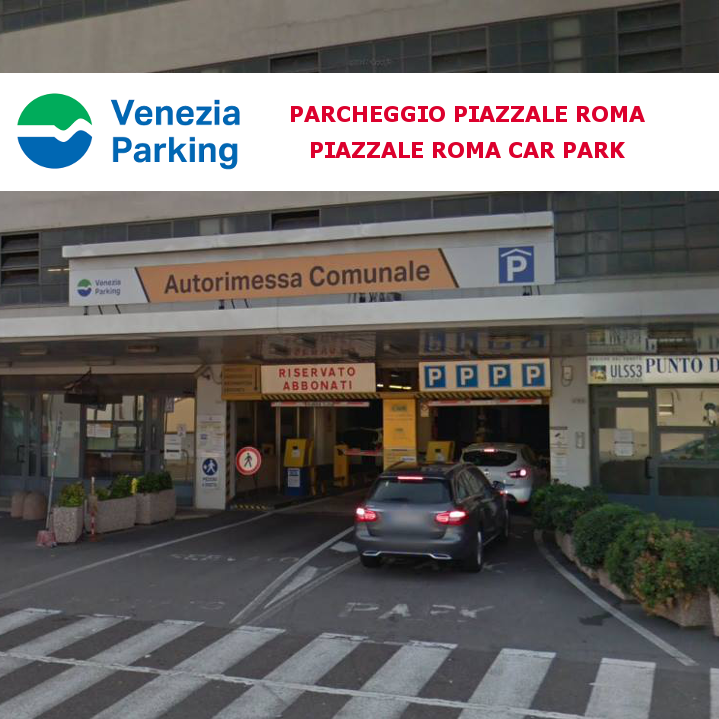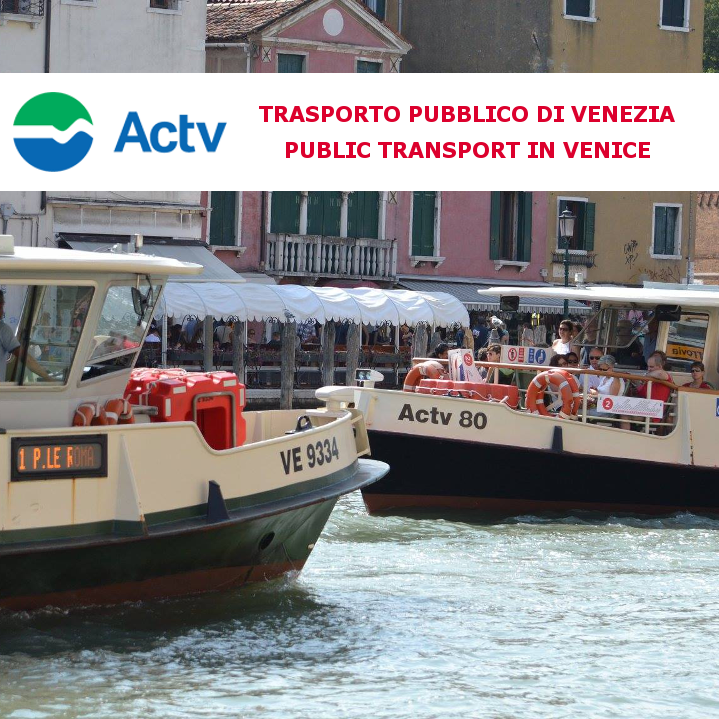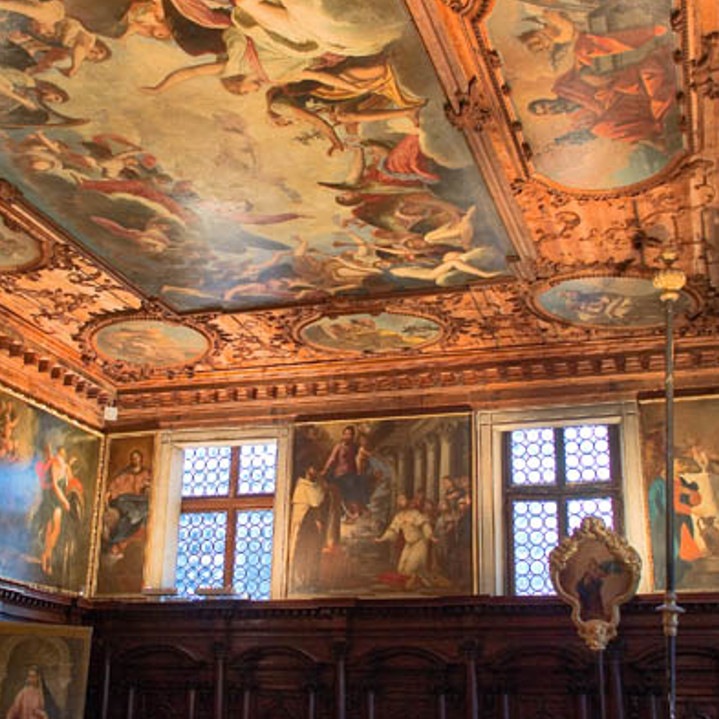You are here
Gardens, fashion, art and green tables: all the colours of shopping and entertainment in Venice
Gardens, fashion, art and green tables: all the colours of shopping and entertainment in Venice
If you're planning a business trip to Venice, set aside at least one day to devote to art and shopping, giving you an opportunity to visit the city’s cultural attractions and its most chic and fashionable venues.
This beautiful walk through the heart of Venice will take you to some of the churches richest in artistic treasures and the lesser-known museums, giving you an opportunity to explore the boutiques and shops on the most famous shopping calle and to discover some historic artisanal weaving factories, ending on a high note with a visit to the Casinò di Venezia (Venice Casino). You can choose to do the whole tour on foot or, alternatively, travel by gondola to the starting point of the various stages.
The itinerary, which lasts around three hours, involves walking and crossing the Canal Grande by gondola ferry, entry into the churches open to visitors, and also a visit to a museum or exhibition if you so wish.
It can start from any point and can therefore vary in duration and length according to your needs.
It is worth knowing that the City of Venice launched the #EnjoyRespectVenezia awareness campaign back in 2017 to promote sustainable tourism. Please ensure that you always conduct yourself in a responsible and respectful fashion towards the city, taking particular note of the following advice:
• Do not stop and stand on bridges
• Keep to the right
• Only purchase goods from authorised retailers
• Use licensed tour guides.
- Duration: 3 hours + 1 hour visit to a museum or exhibition of your choice
- Mode of travel: on foot and/or gondola or vaporetto
- Suggested period: All year round
- Suitable for children: Yes
- Disabled access: Partial
- Departure: Venice Royal Gardens - San Marco district
- Arrival: Ca' Vendramin Calergi - Cannaregio district
- Districts: San Marco, San Polo, Santa Croce, Cannaregio
-
Majour attractions and highlights:
1. Venice Royal Gardens
2. Church of San Moisè
3. Church of Santa Maria del Giglio
4. La Fenice Opera House
5. Campo Sant’Angelo
6. Fortuny Museum
7. Carlo Goldoni Museum
8. Frari Basilica
9. Campo San Giacomo dell’Orio
10. Natural History Museum
11. Ca’ Vendramin Calergi (Venice Casino)
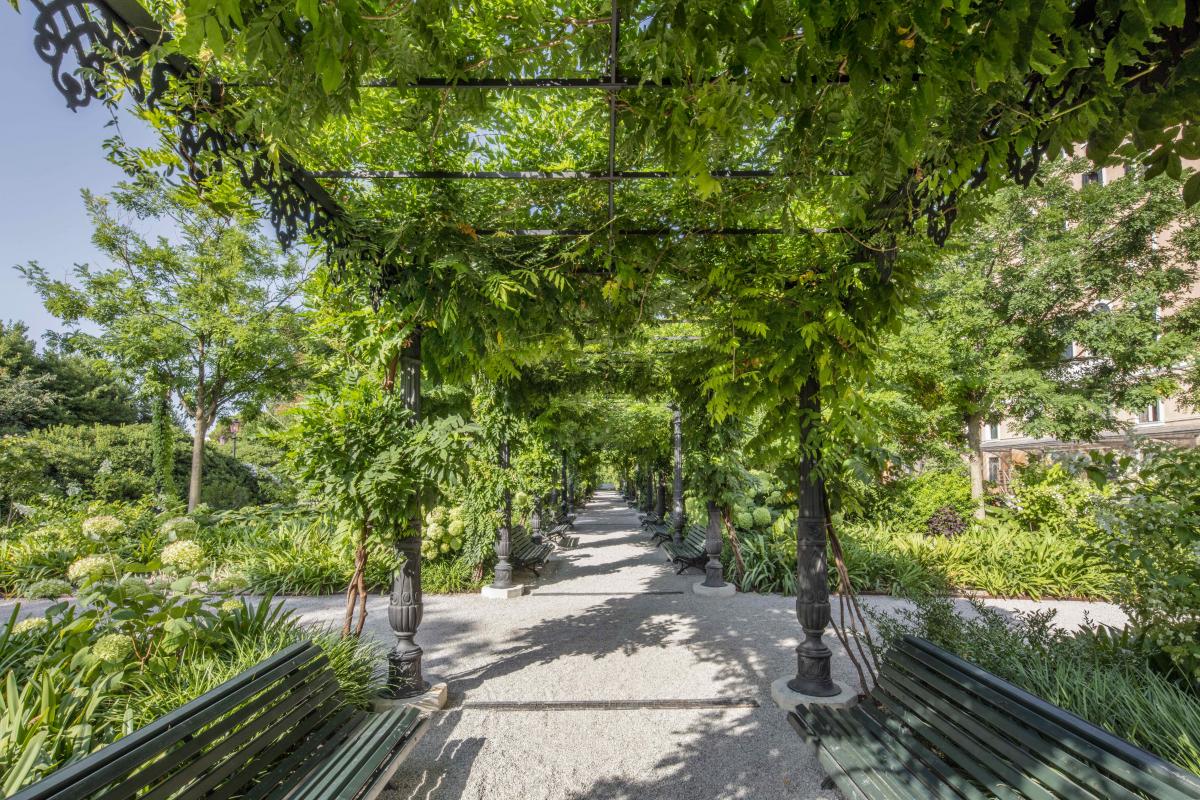
Venice Royal Gardens
ph. Giorgio Bombieri - Comune di Venezia
Departure: Giardini Reali di Venezia
The walk begins at the Giardini Reali di Venezia (Venice Royal Gardens), overlooking the Bacino di San Marco. These gardens will enchant you straight away with their originality and the botanical exuberance of this green space, made up of shadows, light and colours that change with the seasons. New blooms follow on from one another every month, reaching their peak in July, when five thousand blue and white Agapanthus are in flower.
The history of the Giardini Reali dates back to the early nineteenth century, when Napoleon planned to transform the Marciana area to build a new royal palace, the so-called Ala Napoleonica (or Napoleonic Wing), and at the same time endow the palace with a garden, directly connected by a drawbridge.
A greenhouse was built at one end of the garden, on the Ponte della Zecca, towards the square, while at the opposite side there was neoclassical-style pavilion known as the Cafehaus (Padiglione del Caffè), used as a place of court recreation in summer and as a greenhouse in winter. When Venice became part of the Kingdom of Italy, the pavilion was opened to the public as a “coffee house”.
Today, after major restoration work completed in 2019, the Giardini Reali have regained their magnificence and original design. The visit to the Giardini Reali is free of charge. We suggest you sit down for a coffee or an aperitif at the tables of the Padiglione del Caffè before continuing your walk.
Useful information
- Venice Royal Gardens: https://www.venicegardensfoundation.org/en/opening-hours-and-regulations-royal-gardens
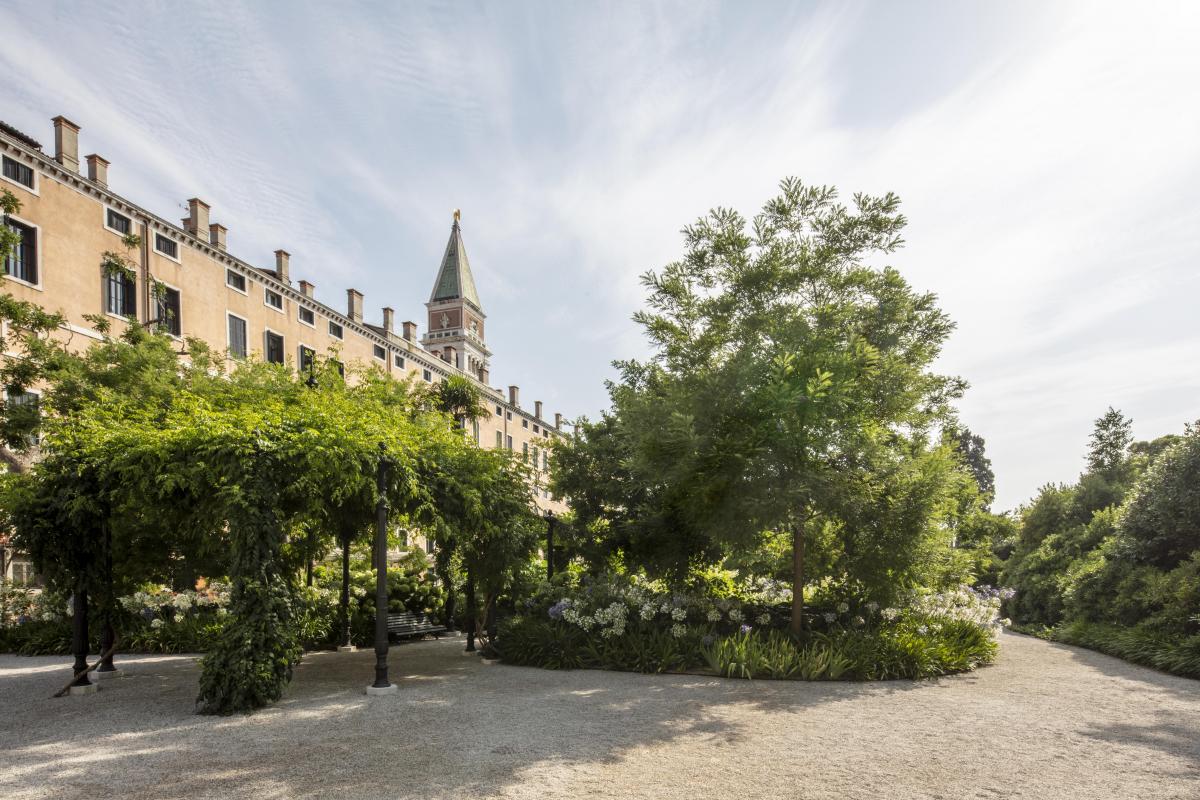
Venice Royal Gardens
ph. Giorgio Bombieri - Comune di Venezia
Stage 1: Calle Larga XXII marzo - Church of Santa Maria del Giglio
For lovers of haute couture, a stroll along Calle Vallaresso, Salizzada San Moisè and Calle Larga XXII Marzo is an absolute must.
They can be reached in a matter of minutes by leaving the Giardini Reali and the café behind and heading to the right into Calle Vallaresso.
Along this stretch of the route you will come across at least three stations where you can hire a gondola to take you directly to the Palazzo del Casinò in a little over an hour. There will be plenty of time on your way to seek advice from the gondoliers, who are always willing to provide information about the city.
Calle Vallaresso is a renowned luxury shopping destination: it is home to the boutiques of the most famous Italian and other international brands, as well as designer shops, where you can purchase the most fashionable garments from the world’s leading fashion houses and the most sought-after pieces of craftsmanship.
At the end of Calle Vallaresso, turning left, you cross the Salizzada San Moisè. The Venetian word “salizzada” has a peculiar history: it is the name given to the widest streets in the city that were also the first to be paved.
Another interesting fact regards Calle Ridotto, which is found on the left as you continue along the salizzada. The name of this calle derives from the fact that the old Palazzo Dandolo, now a hotel, was used as a public “Ridotto” from 1638, meaning a place for gambling, parties and amorous encounters. Closed in 1774, the building was restored in 1936 with the intention of making it the Venice casino, but this was not possible and so in the 1950s Ca’ Vendramin Calergi, which we will see during the last stage of this walk, was chosen as the new location.
Arriving in Campo San Moisè, you cannot fail to notice the Baroque facade of the church that gives the campo its name, dating back to the mid-seventeenth century. Taking a closer look at its bell tower, with its brick dome typical of fourteenth-century churches, you will realise that its Baroque appearance is simply its latest development: the original construction of the church dates back to the eighth century, followed by subsequent rebuilding over the years. Inside, the chapel on the left houses a painting by Tintoretto called The Washing of the Feet and a Last Supper attributed to Palma the Younger. Above the main entrance is a large organ from the mid-eighteenth century, embellished with intricate wooden decorations.
Leaving the church, continue over the bridge to enter Calle Larga XXII Marzo, characterised by luxurious haute couture boutiques. A stroll here is a real must, taking a look at the handbags, clothes and leather goods, but also the handmade local products such as pearls, Murano glassware and textiles. This street takes its name from the date of the city’s liberation from the Austrians and the fact that it was widened in 1880 to provide a more convenient route to connect the centre with the rest of the city.
If you walk almost all the way down the calle, before reaching the Ponte delle Ostreghe, you will come across the Fortuny textile and interior design shop. This is one of the three historical artisanal weaving mills to be found in the city, where silks, velvets, damasks and brocades come to life and end up all over the world, from La Scala in Milan to the Oval Room in the White House, the Royal Palace in Stockholm and the Kremlin in Moscow. If you want to find out more about the artistic textiles of Mariano Fortuny, one of the greatest stylists and designers of the first half of the twentieth century, best known for his exquisite clothes, you can also visit the artist’s studio and residence, which now houses the Fortuny Museum, the next stop on this itinerary. If you love fine fabrics and textiles, don’t miss the opportunity to also visit the two other renowned artisanal weaving factories based in Venice, namely, Rubelli and Bevilacqua.
You may have wondered why the “delle Ostreghe” bridge and street are known by this unusual name: it’s simple, this is probably where oysters were once sold. Design and antique shops now line this short stretch.
At the end of Calle delle Ostreghe you come to Campiello di Santa Maria Zobenigo, dominated by the majestic white facade of the church of the same name, also known as the church of Santa Maria del Giglio. This name derives from the Jubanico family, who are said to have founded the sacred building in the ninth century. The church as we see it today is the result of several renovations, while the facade was rebuilt in the second half of the seventeenth century in the typical Baroque style of the time. Commissioned by the Barbaro family, it is a monument celebrating the military successes achieved by Antonio Barbaro, Captain da Mar of the Serenissima: effigies of the captain and his four brothers can be seen, along with depictions of the locations of his sea battles in the name of the Venetian Republic.
Useful information
- Gondola tours: https://www.veneziaunica.it/en/content/practical-information#gondola
- Church of San Moisè: http://www.parrocchiemap.it/parrocchiemap/consultazione/parrocchie/scheda.jsp?icsc=7550070
- Patriarcato di Venezia: http://www.patriarcatovenezia.it/vita-pastorale/beni-culturali-e-turismo/
- Fortuny Showroom and Gardens: https://fortuny.com/venice/
- Church of Santa Maria del Giglio: https://chorusvenezia.org/visita/chiesa-di-santa-maria-del-giglio/
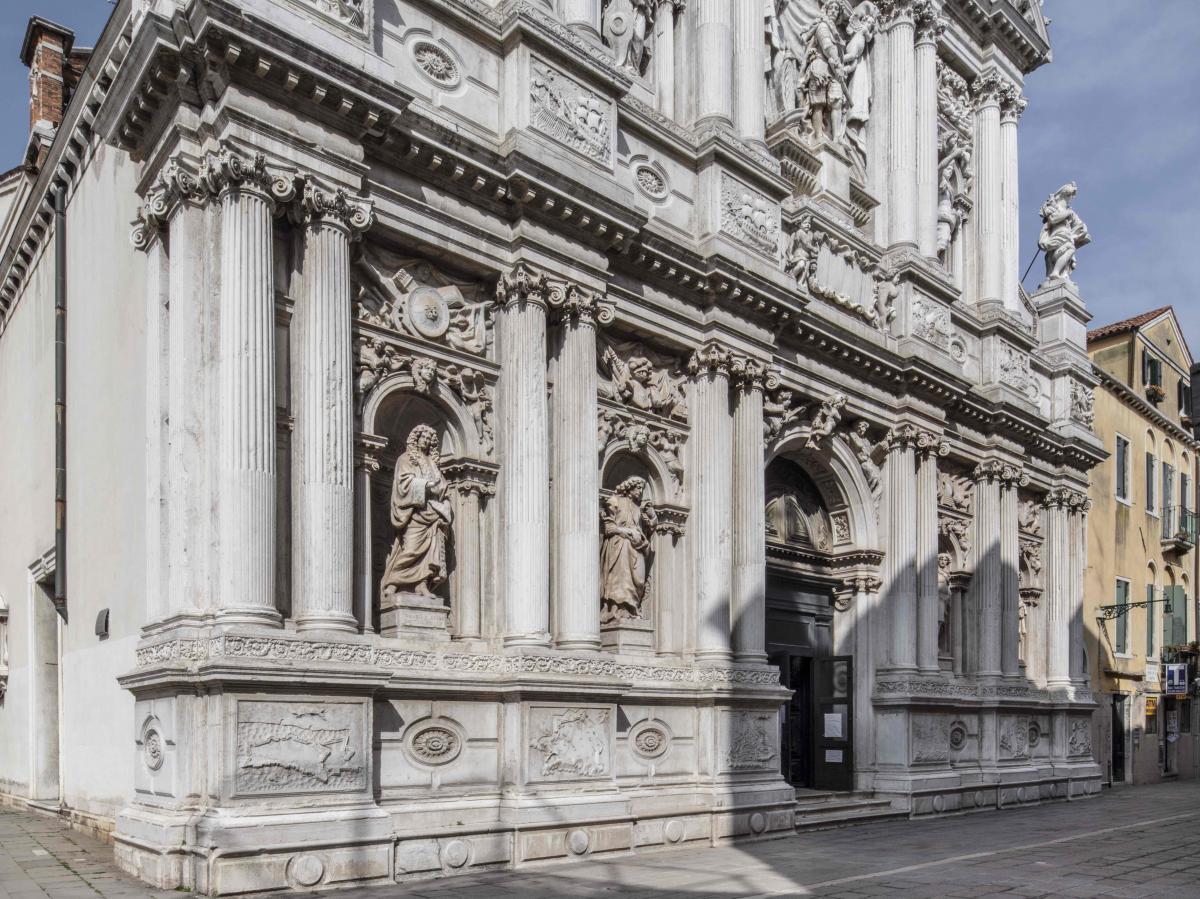
Church of Santa Maria del Giglio
ph. Giorgio Bombieri - Comune di Venezia
Stage 2: Campo Santa Maria Zobenigo – Fortuny home and museum
Leaving the church on the left, continue towards Calle del Piovan or Gritti.
From the canal you can admire the back of the Gran Teatro la Fenice, which can be recognised thanks to the phoenix carved on the corner wall and stands out because of the large canopy protecting the water gate.
The theatre is open for visits every day and houses a permanent exhibition dedicated to Maria Callas and her years in Venice.
Turn left along Fondamenta della Fenice, cross the crooked bridge and then turn right straight away into Calle dei Callegher. Continue over the bridge towards Calle Caotorta and make your way to Campo Sant’Angelo. This campo owes its width to the fact that the church that once stood here was demolished in 1837 and never rebuilt. From here, you can admire Palazzo Duodo, the red building on the corner where the famous composer Domenico Cimarosa lived and died, and the leaning bell tower of the church of Santo Stefano. Cutting diagonally across the campo, you will notice Palazzo Gritti Morosini (house number 3832) on the opposite side, on your way to the opposite corner where you will enter Calle dei Avvocati, so called because several law offices can still be found there. The initial part of the calle, near the campo, is characterised by a building from which wooden beams protrude at first floor level.
Turning into the Ramo Michiel on your right, you will come to Campo San Beneto. Here you will find the Mariano Fortuny home and museum, where the Spanish artist lived from 1898 to 1949, the year of his death. Described as an eclectic figure and an artistic innovator, Fortuny was a stylist, stage designer, painter, photographer and designer. We recommend not missing out on a visit to this museum: you will enjoy a unique experience in a refined venue, elegantly decorated with paintings, lighting installations, clothes, textiles, colours and dyes. The visit lasts about half an hour.
During his time in Venice, Fortuny founded the first textile workshop with his wife Henriette Negrin, where they worked together to create Delphos, the pleated silk dress that made him world famous. Mariano Fortuny was a leading participant in Venetian cultural life, thanks to which he discovered the philosophy of Richard Wagner, from whose music he drew inspiration to create his own works of art. He also took an interest in set design and lighting technology, thus achieving a fusion of music and theatrical painting. Indeed, one of the leitmotifs of this itinerary is the link between Mariano Fortuny’s artistic expressions and those of Richard Wagner: the last stop is Ca’ Vendramin Calergi, where the German composer lived the last months of his life.
Leaving the museum, stop to observe an all-Venetian peculiarity that characterises this campo, like many others in the city: the campo stands at approximately 70 cm above street level. This elevation, at a height that cannot be reached by salt water in the event of a high tide, was once a veritable cistern for collecting rainwater, which was channelled here through the manholes on the four sides, and then drawn from the well in the centre.
Leaving the museum behind, turn left again and take the Ramo del Ponte dell’Albero. After crossing the bridge, continue to the right and you will come out into Corte dell’Albero. Then take the Ramo Narisi to the left and continue along an iron bridge that leads to Piscina San Samuele. The name Piscina derives from the function of this place in the past. Before being filled in and transformed into a surface that can be walked on, the “piscine” were once pools for fishing and swimming.
In Piscina San Samuele you can visit the Rubelli showroom. This renowned Venetian weaving mill has been in business since 1835, specialising in exclusive furnishing fabrics and velvets that are still woven on hand looms. Next to the showroom is the Rubelli historical archive, which houses a collection of more than 6000 fabrics from the fifteenth century onwards. The archive can be visited by appointment.
From here you can take Calle del Traghetto or Ca’ Garzon, which leads to the gondola ferry, an excellent alternative to the vaporetto, which allows you to cross the Canal Grande in just a few minutes aboard a rowing boat that can accommodate up to twelve people.
Useful information
- La Fenice Opera House: https://www.teatrolafenice.it/en/la-fenice-foundation/visit-us-2/
- Fortuny Museum: https://fortuny.visitmuve.it/en/home/
- Rubelli Historical Archive: http://www.rubelli.com/en/archivio-storico/
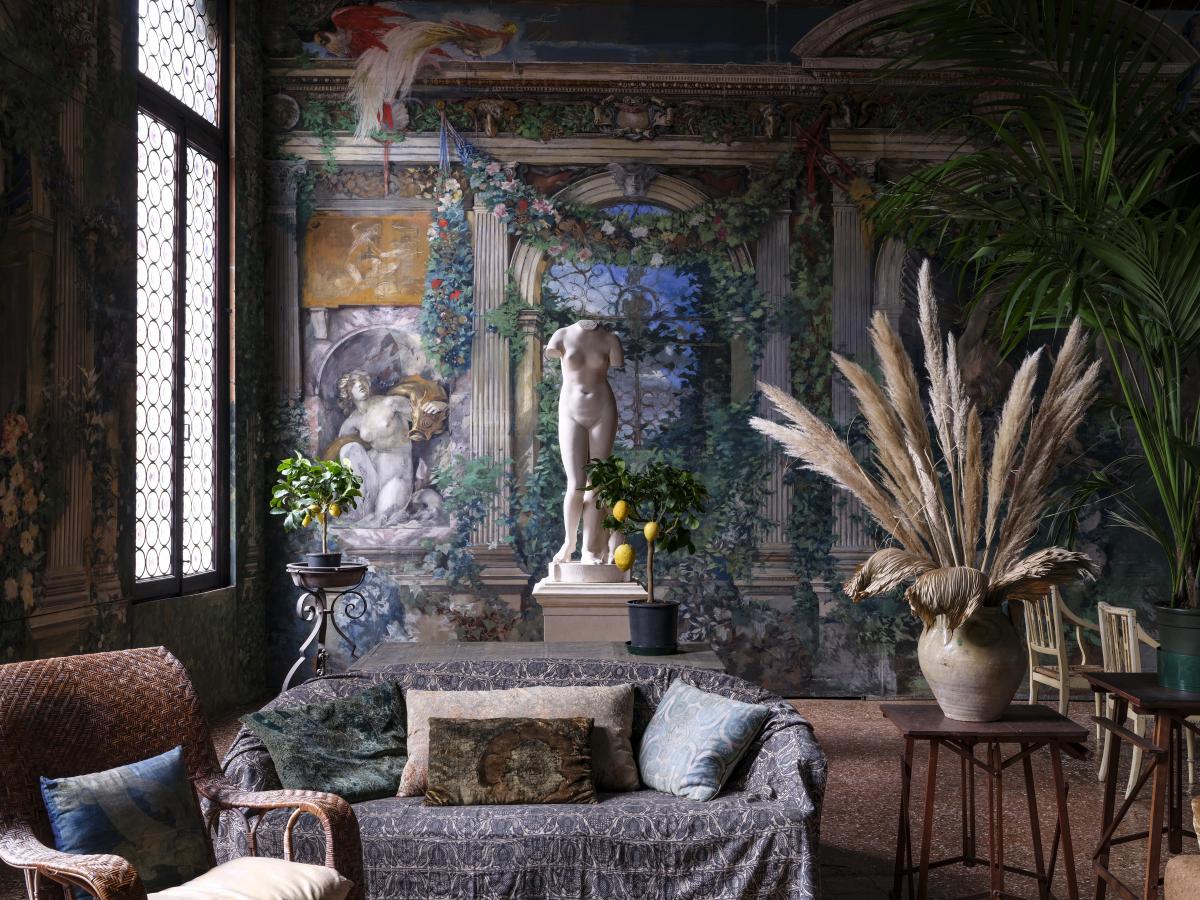
Fortuny Museum
ph. Massimo Listri - Archivio fotografico Fondazione Musei Civici di Venezia
Stage 3: Fortuny Museum - San Marcuola
After getting off the gondola ferry, continue along the fondamenta, turn left into Calle del Traghetto and you will find yourself in Campiello San Tomà.
Turn right towards the canal and then right again, where you will immediately see a bridge and the palace above it: this is the fifteenth-century Palazzo Centanni, where the playwright Carlo Goldoni was born in 1707 and spent his childhood.
If you have about half an hour to spare, we recommend a visit to the maestro’s home and museum, where you can admire the characteristic spaces of a Venetian palace, with the small courtyard and water gate on the ground floor and the actual house on the first floor. It also houses a small puppet theatre dating back to the eighteenth century.
After leaving the museum, we continue on a design and craft shopping tour, exploring workshops and studios where you will find bags, jewellery, accessories, miniature models of Venetian boats and Murano glass objects.
From the museum, continue along Calle Nomboli and then Rio Terà dei Nomboli. Turn right in the direction of Rialto – San Marco, following the yellow signs indicating the direction. After about ten metres you will come to Calle Seconda dei Saoneri. At the end, turn left towards Ferrovia – Piazzale Roma.
Once you reach the fondamenta, turn right and, before you continue along the Fondamenta dei Frari, your eyes will be drawn to the imposing Basilica dei Frari, a church housing splendid pictorial masterpieces by Titian and Giovanni Bellini, as well as the tombs of Titian himself and Antonio Canova. A visit to this important piece of Venice’s architectural and artistic heritage is a real must and will take just over half an hour.
From the Fondamenta dei Frari proceed towards the bridge and then turn right immediately into Calle della Chiesa. You will then reach Campo San Stin, where you should take the first calle on the right, Calle di Ca’ Donà or del Spezier.
Continue in the same direction until you reach Calle del Calice, and follow the sign for Al vaporetto San Stae. When you reach Campo San Boldo, you will spot the remains of an ancient bell tower leaning against a palace, commemorating the church that once stood here and was demolished in the nineteenth century. The old church was dedicated to Sant’Ubaldo, from whom the name Boldo derives.
Now cross the bridge on the left. From here, if you wish, you can hire a gondola to continue the itinerary. However, if you choose to continue on foot, turn left and shortly afterwards you will come to Campo San Giacomo dell’Orio.
The campo contains a few benches where people can take a rest in the shade, a drinking fountain and several taverns and trattorias where you can eat.
The centre of this large campo is occupied by the apse of the church of San Giacomo dell’Orio. The church is actually named after the apostle San Giacomo Maggiore (St James the Great), but the name Orio probably derives from the union of the words dal-rio. It is interesting to note that the church facade faces the water and not the campo.
We continue on our way, leaving the apse of the church on the left towards the bridge. Turning left again along a narrow calle, we reach the Salizada del Fontego dei Turchi. Here we find ourselves in the perfect position for a glimpse of the unfinished facade of the church of San Marcuola, across the Canal Grande.
We pass by the Museo di Storia Naturale (Natural History Museum), one of the city’s eleven civic museums, which houses various natural history collections. The museum also has a café on the ground floor, with tables outside facing the museum’s lovely garden.
The museum is housed in a prestigious palace, the Fontego dei Turchi, overlooking the Canal Grande. Its main facade, on the canal, is visible from the water’s edge, or from the vaporetto when crossing the Canal Grande to reach Ca’ Vendramin Calergi.
The palace as we see it today is the result of reconstruction work carried out in 1860, when the building became the property of Venice City Council. Its history, as one can easily guess from its name, is closely linked to the Turks. In fact, it is called Fontego dei Turchi because it was the casa-fondaco (or warehouse) where the Serenissima allowed Turkish merchants to settle in 1621 and where they remained until 1838. In order to separate the activities of the Turks from the rest of the city, the building underwent various modifications with respect to its original form, dating back to the fourteenth century. The Turks built their warehouses, a mosque and a Turkish bath on the ground floor, while the upper floors were used for living quarters.
If you love handcrafted fabrics for interiors and haute couture, we suggest making a detour to the Luigi Bevilacqua weaving mill, which is a few hundred metres from the Museo di Storia Naturale. Take Calle dei Preti next to the church, which in fact runs alongside the church of San Zan Degolà, and then on the left, having passed the church facade, cross the bridge, continuing along the fondamenta to the right. After about thirty metres you will come to the historic Luigi Bevilacqua weaving mill, which has been manufacturing fine fabrics since 1875, still using eighteenth-century looms today that were recovered from the ancient Scuola della Seta della Serenissima (Venetian Silk School).
It takes just a few minutes to get to the start of the last stage from the Museo di Storia Naturale, following signs for the San Stae stop and taking a vaporetto towards Ferrovia - Piazzale Roma. After just one stop, you will be on the opposite side of the canal, at the San Marcuola stop.
Useful information
- Basilica dei Frari: https://www.basilicadeifrari.it/en/
- Carlo Goldoni Museum: https://carlogoldoni.visitmuve.it/en/home/
- Natural History Museum: https://msn.visitmuve.it/en/home/
- Fondazione Musei Civici di Venezia: https://www.visitmuve.it/en/home/
- Church of San Giacomo dall'Orio: https://chorusvenezia.org/visita/chiesa-di-san-giacomo-dallorio/
- Luigi Bevilacqua weaving mill: https://www.luigi-bevilacqua.com/en/
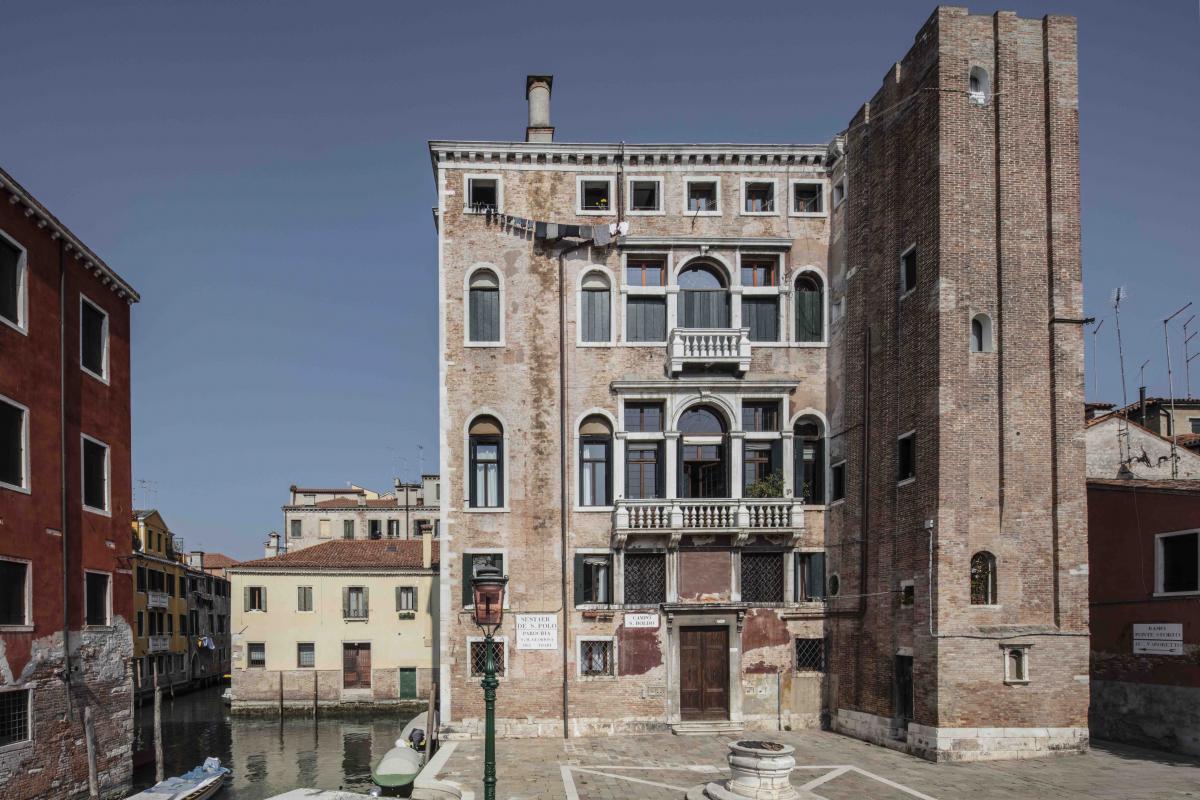
Campo San Boldo
ph. Giorgio Bombieri - Comune di Venezia
Stage 4: San Marcuola - Ca' Vendramin Calergi
Once you get to San Marcuola, proceed along Calle San Marcuola, then at the junction with Rio Terà drio la Chiesa turn right towards the crooked bridge and continue for a few metres along the Fondamenta on the left. Now turn right until coming to number 2040, where you will find the entrance to Ca’ Vendramin Calergi, home of the Casinò di Venezia (Venice Casino). This imposing palace, overlooking the Canal Grande and endowed with a beautiful garden, was completed in the early sixteenth century by the architect Mauro Codussi, while the wing bordering the garden dates back to the mid-seventeenth century.
The Casinò di Venezia is the oldest gambling house in the world: founded in 1638, it was originally based at the Ridotto di San Moisè, near the church and the campo mentioned in the first stage of this itinerary.
Today Ca’ Vendramin Calergi houses not only the casino but also the Wagner Museum, where you can visit the apartment where Richard Wagner stayed during the final months of his life. The composer died in one of these very rooms.
A commemorative plaque on the brick wall overlooking the Canal Grande bears an inscription in verse by the poet Gabriele D’Annunzio.
During his stay in Venice, Wagner occupied the entire mezzanine floor of the palace with his family, reserving the rooms where the museum is now located for himself. These rooms feature a display of manuscripts and other memorabilia collected by the Associazione Richard Wagner di Venezia, which together constitute the largest private collection dedicated to Wagner outside Bayreuth.
In Venice, before his death on 13 February 1883, the German musician had completed the second part of Parsifal and conducted the Christmas Eve concert in one of the Apollinee halls of the Teatro la Fenice in 1882. After the concert, the composer himself donated his conductor’s baton and music stand to the Conservatorio di Musica di Venezia, which are now kept in Palazzo Pisani, in the Music Museum of the Benedetto Marcello Music Conservatory.
Useful information
- Ca' Vendramin Calergi: https://www.casinovenezia.it/en/venues/cavendramincalergi
- Wagner Museum: https://www.casinovenezia.it/en/wagner-museum
- Venice Music Conservatory "Benedetto Marcello": https://www.veniceontop.com/en/visita-il-conservatorio/
Ca' Vendramin Calergi
ph. Comune di Venezia
Sources
-
Guida Rossa Touring Club Italiano, Venezia, La biblioteca di Repubblica, 2005
-
Giulio Lorenzetti,Venezia e il suo estuario, 1974
-
Giuseppe Tassini, Curiosità veneziane. Ovvero origini delle denominazioni stradali di Venezia, Filippi editore, Venezia



